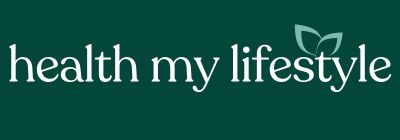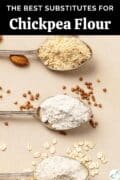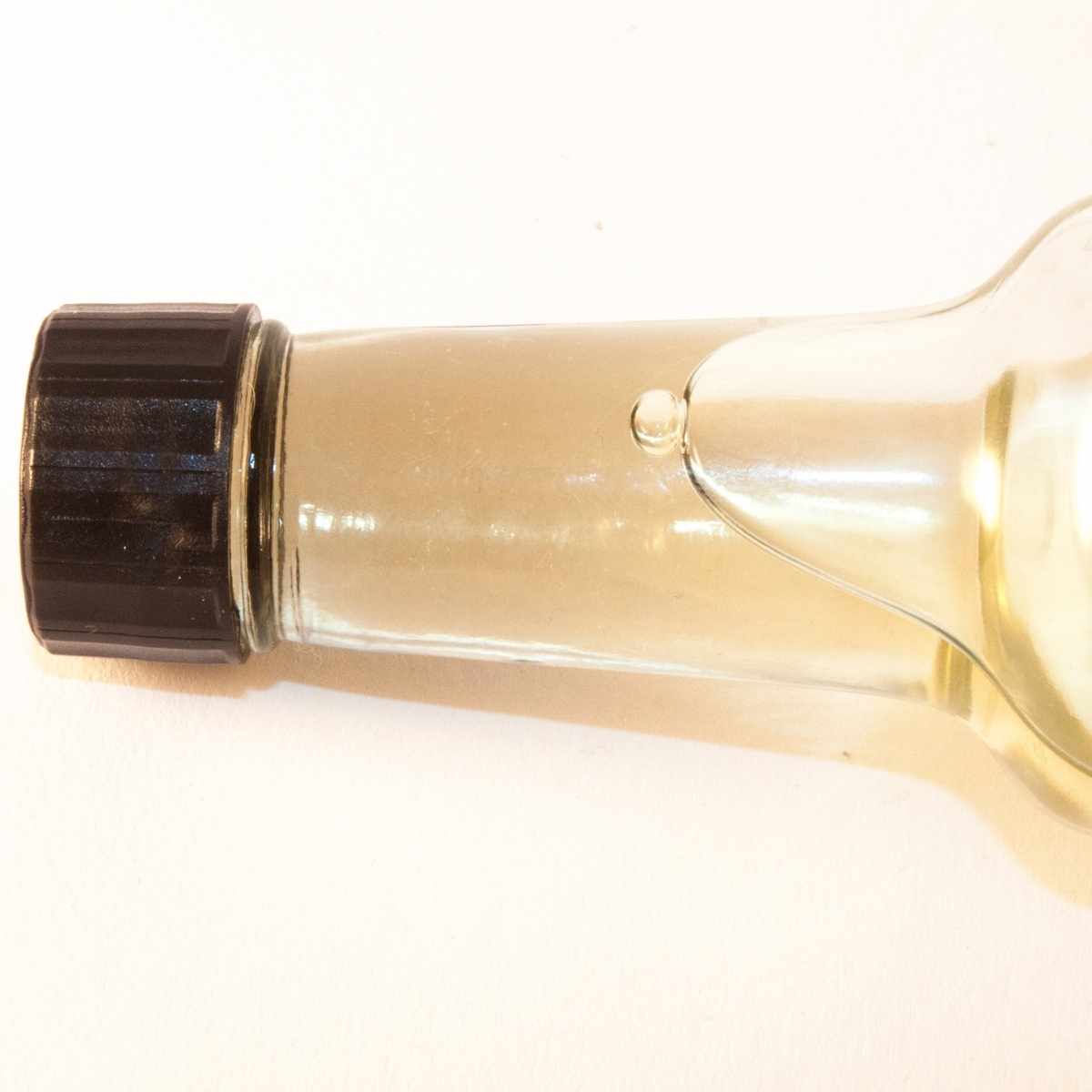Are you out of chickpea flour, or just looking for the best substitute? We’ve got you covered! Here are the 15 best chickpea flour substitutes, plus how to use them so you can find the perfect fit for your recipe!
This post may contain affiliate links. Read my policy page for more information.

Jump to:
What is chickpea flour?
Simply put, chickpea flour is a gluten-free flour made from ground chickpeas. Depending on the types of chickpeas being used, there are different kinds of chickpea flour.
The most popular kind (and the one I’m talking about today) is made from chickpeas called Bengal gram or garbanzo, hence why we sometimes call chickpea flour gram flour or garbanzo bean flour.
Nowadays, you can find chickpea flour in most grocery stores. But, you can also make chickpea flour at home using just one ingredient—chickpeas!

What is it used for?
Chickpea flour is a traditional ingredient in Indian cuisine. In the last few years, it has grown in popularity in the West, thanks to its properties to act as a substitute for white flour and its nutritional value.
There are a few things that make it appealing. First, it works as a binding agent and thickener for burgers, patties, fritters, and more.
And second, it can replace eggs and flour, making it suitable for people who are following a vegan or gluten-free diet.
My favorite ways to use it are in a chickpea flour frittata and chickpea flour scramble, but you can add it to almost any recipe, no matter sweet or savory.

Best substitutes for chickpea flour
Chickpea flour is a great gluten-free alternative to wheat flour, but it can be hard to find in some areas and is often on the pricier side. Whether you’re looking for a similar gluten-free flour to chickpea flour, or you’re hankering to make a recipe that calls for it and can’t find any, these are the best substitutes for chickpea flour! From almond flour to quinoa flour, these alternatives will help you create delicious dishes without having to search far and wide for chickpea flour.
1. All-purpose flour

For a quick and easy chickpea flour substitute, you can’t go wrong with all-purpose flour. It’s a budget-friendly and accessible alternative to chickpea flour. Here is how to use it:
- All-purpose flour, or any type of wheat flour, is not as absorbent as chickpea flour. This means that for every 1 cup of chickpea flour, you’ll need to use 1 1/4 cups of all-purpose flour.
- It’s important to consider that all-purpose flour contains gluten and chickpea flour is gluten-free. This means that this substitute is not applicable if you’re cooking for someone with celiac disease.
- All-purpose flour is lower in protein and fiber compared to chickpea flour, and higher in carbs. So, if we’re talking texture, chickpea flour is denser while wheat flour is lighter.
2. Almond flour

Almond flour, or almond meal, is made from grounded blanched almonds. Therefore, it’s higher in fat than chickpea flour and it has a nutty taste.
If we’re talking price, almond flour is more expensive than chickpea flour, but it makes for a great substitute! Here’s how to use it:
- Substitute chickpea flour with almond flour with a 1:1 ratio. You may need to add a little bit more liquid as almond flour is more absorbent, but that will depend on the recipe.
- You can make your own almond flour by grinding raw blanched almonds in a high-speed blender.
- This substitute is best used in baked goods such as cookies, cakes, pancakes, etc.
- It’s not suitable for people with a nut allergy. If you’re cooking for someone who is allergic to nuts, it’s best to choose a different substitute.
3. Coconut flour

Another great chickpea flour substitute is coconut flour. It’s made from dried coconut meat and is higher in fat than chickpea flour.
This type of flour is best for baking, but it can also be used in savory dishes in moderation. Follow these tips for the best results:
- For every 1 cup of chickpea flour, use 1/3 – 1/2 cups of coconut flour. Coconut flour is VERY absorbent. If you add too much your food may turn out dry and rubbery. Start with a small amount like 1/3 cup for 1 cup of chickpea flour, then add a few more tablespoons if needed.
- Depending on how much you’re using, it can give foods a strong coconut flavor and aroma, so keep that in mind if you’re choosing it as a substitute.
- It’s suitable for people who are following a low-carb diet. It’s also gluten-free, high in protein and fiber, and a good source of potassium and iron.
4. Brown rice flour

Brown rice flour is high in vitamins and minerals and is naturally gluten-free. As the name suggests, it’s made from ground brown rice.
- For every 1 cup of chickpea flour, use 3/4 cup of brown rice flour.
- Brown rice flour is lower in protein, fiber, and fats than chickpea flour but higher in carbs. It’s gluten-free and nut-free, and you can find it in most grocery stores.
- As with most flours that don’t contain gluten, this one is best used in a blend with other gluten-free flours. Using it alone in baked goods can lead to flat cakes, bread, pancakes, etc.
5. Oat flour

Oat flour is a great budget-friendly flour that you can find in most grocery stores, or that you can easily make at home! Here’s how to use this simple chickpea flour substitute:
- Use as a substitute for chickpea flour following a 1:1 ratio.
- Note that it can be slightly grainy and leave a nutty taste.
- You can make it at home by blending rolled oats in a high-speed blender until you have a fine powder.
- It’s a great source of protein, fiber which helps support a healthy weight, and rich in manganese, magnesium, copper, and more! It can also be made gluten-free by using gluten-free-certified oats.
6. Spelt flour

Spelt flour is similar to wheat flour, but it’s not as refined and is higher in fiber and protein. It has a sweet and slightly nutty flavor and aroma, but in general, it’s pretty neutral-tasting.
- For every 1 cup of chickpea flour, use 3/4 cup of spelt flour. This is because spelt flour is more absorbent than chickpea flour, so you’ll need roughly 1/4 cup less.
- It has gluten, which means it’s not suitable for people following a gluten-free diet.
- Best for baked goods like cookies, cakes, cupcakes, etc. Not suitable for breads that need kneading, as the gluten is not strong enough and will “break” after mixing the dough for too long.
7. Cassava flour

Cassava flour, or tapioca flour, is made from ground cassava root and is popular in Latin American, African, and Caribbean cuisines. It has a mild and slightly sweet flavor and a starchy texture.
- As a general rule, you can use cassava flour in place of chickpea flour with a 1:1 ratio. Depending on the recipe you may need to adjust the liquid or the amount of flour used to achieve the desired consistency.
- Cassava flour does not have the same high protein content as chickpea flour. So it may not work as well in recipes that require structure and binding, such as in falafel or chickpea omelets.
- It’s rich in fiber and nutrients such as folate, vitamin C, and potassium. It’s also gluten-free, which makes it great for those with allergies or gluten sensitivity.
- And last, but not least, it has a low glycemic index, which means it doesn’t cause a sharp increase in blood sugar levels after consumption.
8. Arrowroot starch

Arrowroot starch is a type of starch extracted from the arrowroot plant. It has a neutral taste and a fine texture and is naturally vegan and gluten-free.
In recipes, it’s mostly used as a thickener in sauces, custards, and puddings.
- For best results, use a 1:1 substitution ratio. This means that if a recipe calls for 1 cup of chickpea flour, you can use 1 cup of arrowroot starch instead.
- Keep in mind that this substitution is best applied when chickpea flour acts as a thickening agent.
- If a recipe uses chickpea flour for texture and volume, it’s best to choose a different substitute.
9. Amaranth flour

Amaranth flour is a type of flour made from the seeds of the amaranth plant, which is a gluten-free pseudo-cereal. The plant is native to North and Central America and is used as a whole grain.
It has a slightly sweet, nutty flavor and is often used in gluten-free baking as a substitute for wheat flour. To use it as a chickpea flour substitute, follow these recommendations:
- Use the same amount of amaranth flour as you’d use chickpea flour.
- This type of flour can absorb more or less liquid depending on the recipe, so adjust it as needed.
- For best results, use it in addition to other gluten-free flours such as quinoa flour and almond flour.
10. Sorghum flour

Sorghum is a gluten-free grain that is grown in Africa, Asia, and most parts of America. After it’s dried and grounded, you’re left with sorghum flour. Here are the best ways to use it:
- When substituting chickpea flour with sorghum flour, use a 1:1 ratio.
- This type of flour has a mild, slightly sweet flavor, and a smooth and fine texture. You can use it to make porridge, pancakes, thicken soups, or whisk it into baked goods.
- Note that sorghum flour has a finer texture than chickpea flour, so it will produce different results depending on the recipe. It can make baked goods flatter than if you used chickpea flour.
11. Buckwheat flour

Buckwheat flour is made from ground buckwheat grouts. This type of flour is high in fiber, magnesium, potassium, and B vitamins. It’s also low in fat and calories and is naturally gluten-free. Follow these tips for substitution:
- You can use buckwheat flour as a substitute for chickpea flour using a 1:1 ratio.
- Use it in baked goods such as pancakes, crepes, muffins, and even cinnamon rolls. You can also use it as a gluten-free flour in savory dishes like quiches and tarts.
- It’s important to keep in mind that buckwheat flour has a unique nutty and earthy flavor that can be quite strong, which may not work well in all recipes.
- This flour also has a distinct brown-ish color, which may affect the color of the final dish, especially baked goods.
12. Rye flour

Rye flour has a distinct flavor—it’s sour, earthy, and slightly bitter. This is quite different from what chickpea flour tastes like, but you can still use it as a substitute. Here’s how:
- Generally, you can use the same amount of rye flour as the recipe calls for chickpea flour.
- Just keep in mind that you may need to adjust the amount of liquid added to get the desired consistency, as rye flour absorbs more liquid than chickpea flour.
- This flour is best used in savory dishes like pie crust, crackers, bread, etc. It has a stronger flavor than some of the other substitutes on this list, which may not be suitable if you’re making a sweet recipe.
- Rye flour contains gluten, so let people know if they have celiac disease or gluten sensitivity.
13. Millet flour

It’s made from ground millet, which is considered an ancient grain. Millet is popular in countries like Asia and Africa, where it’s a kitchen staple.
- You can use it as a direct substitute with a 1:1 ratio. Millet is lighter than chickpea flour, so it may produce different results depending on what you’re using it for.
- It tastes sweeter than other gluten-free flours, which makes it ideal for sweet recipes.
- Millet flour is healthy and good for you too! Packed with protein, fiber, magnesium, potassium, phosphorus, and B vitamins.
14. Quinoa flour

This is a nutritious and versatile gluten-free flour made from ground quinoa seeds. It has a nutty flavor and aroma, similar to chickpea flour, but it’s not as strong-tasting. For best results, here’s how to use it:
- You can substitute chickpea flour with quinoa flour with a 1:1 ratio.
- Quinoa flour has a finer texture than chickpea flour, which makes it easier to work with in some recipes. However, it may not provide the same structure or binding as chickpea flour does.
- You can use it in many dishes from bread, muffins, and pancakes, to sauces, soups, and stews.
- Quinoa flour is a great source of protein, fiber, and different vitamins and minerals. It contains all nine essential amino acids, making it a complete plant-based protein.
15. Teff flour

If you’ve never heard of teff flour before, you’re in the right place! This is a type of flour made from a small grain called teff, which is native to Ethiopia. It’s the same flour used to make Injera, a spongey flatbread that is a staple in Ethiopian cuisine.
It’s naturally gluten-free and has a semi-neutral flavor, making it a great substitute for chickpea flour!
- Use a 1:1 ratio when substituting teff flour for chickpea flour.
- Teff flour has a unique flavor with a nutty aroma, and it’s also denser than chickpea flour. It works best in baked goods that can carry that dense texture, such as in gluten-free bread, flatbread, pancakes, waffles, etc.
- It can give foods a darker color compared to if you’re using chickpea flour. Keep that in mind when you’re preparing your recipe.
FAQs
Chickpea flour is one of the most nutritious types of flour out there. It’s high in protein, fiber, manganese, iron, copper, magnesium, and more!
It’s a great alternative to wheat flour if you’re looking to add more fiber to your diet.
Store chickpea flour in an airtight container, away from direct sunlight, for up to 6 months.
Summary
As you can see, there are many different chickpea flour substitutes that can work. Which one you choose will depend on a few factors such as which recipe you’re making with it and its role in the dish.
Now that we’ve covered everything, let me know which one you’re going to try first. Leave me a comment below and share with us how it went!
More substitution guides
Need more quick kitchen substitutions? Here are some more quick and easy guides:
- These are the best Coconut Vinegar Substitutes plus an easy homemade alternative.
- Honey Substitutes guides you through all the liquid sweetener options that work best for replacing honey.
- Nutritional yeast is a tricky ingredient but this guide to alternatives makes it easy to know what to use!
- If you need a quick substitute for coconut sugar, look no further! You’ll find all of the best options in both granular and liquid form.







